Birds with Mohawk
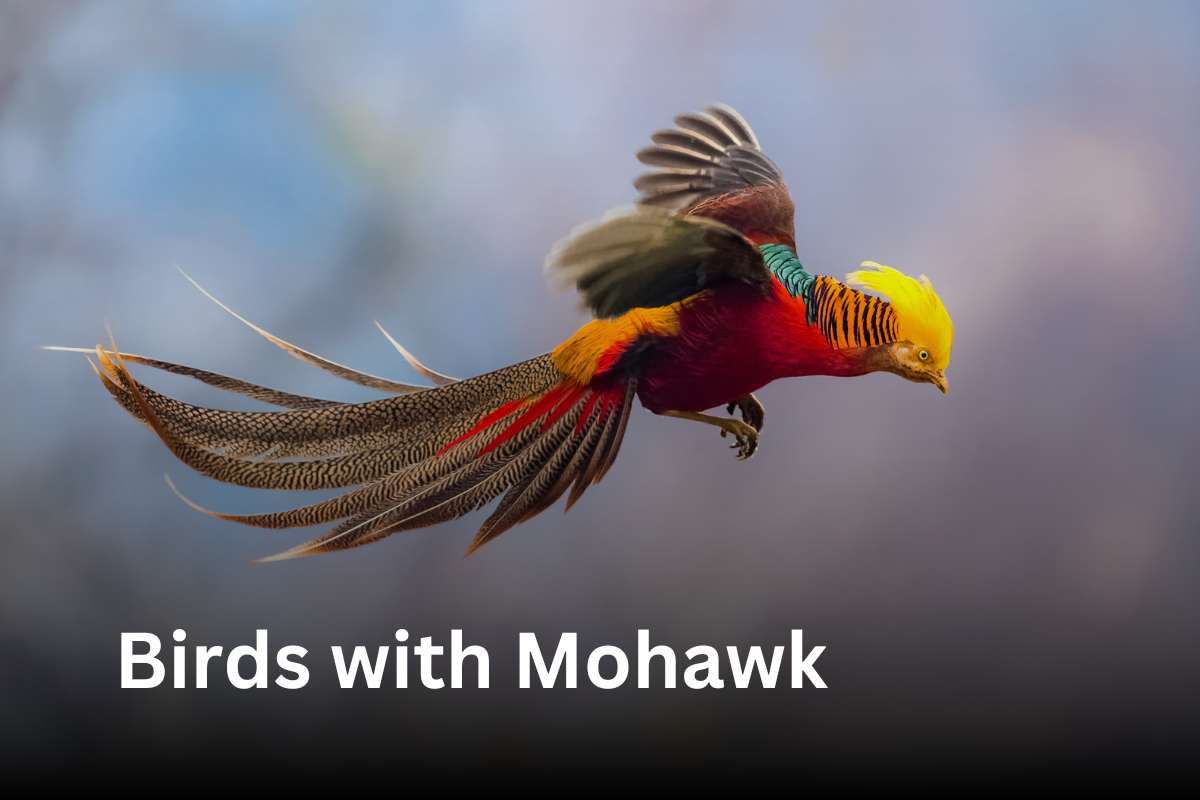
When we think of a mohawk, punk rockers from the 1970s and 1980s may come to mind. Nature, on the other hand, was ahead of the game, providing many bird species with this eye-catching characteristic long before it became a human fashion statement.
Birds with mohawks are not only a reminder of nature’s diversity but also a vivid illustration of the miracles of evolution.
These birds, which have crests or tufts of feathers on their heads, display this trait for various purposes, from wooing mates to intimidating rivals and predators.
So, let’s take a look at these birds and learn more about them.
Why Do Birds Have Mohawks?
The existence of a mohawk in birds is due to evolutionary pressures and adaptations.
These crests are mainly used as a nonverbal communication technique, especially in courting rituals and territorial disputes.
Birds may erect or flatten their crests at will, conveying anger, surrender, or readiness to mate.
Furthermore, these crests can act as camouflage, breaking up the bird’s shape among plants and shadows, thereby shielding it from predators.
In some situations, the crest helps deter possible predators or rivals, making the bird appear larger and more fearsome than it is.
17 Birds With Mohawk
Mohawks aren’t only a human fashion; they also exist in the bird world. Several bird species have stunning mohawk-like crests that add style to their look and captivate bird fans worldwide.
Now, let’s take a look below at the 17 birds’ distinguishing features and mohawk styles.
- Tufted Titmouse (Baeolophus Bicolor)
- Crested Auklet (Aethia Cristatella)
- Cockatiel (Nymphicus Hollandicus)
- Sulphur-crested Cockatoo (Cacatua Galerita)
- Crested Guineafowl (Guttera Pucherani)
- Blue Jay (Cyanocitta Cristata)
- Victoria Crowned Pigeon (Goura Victoria)
- Eurasian Hoopoe (Upupa Epops)
- Great Curassow (Crax Rubra)
- Smew (Mergellus Albellus)
- Pileated Woodpecker (Dryocopus Pileatus)
- Royal Flycatcher (Onychorhynchus)
- Hooded Merganser (Lophodytes Cucullatus)
- Golden Pheasant (Chrysolophus Pictus)
- Turaco (Musophagidae)
- Great Bowerbird (Chlamydera Nuchalis)
- Steller’s Jay (Cyanocitta Stelleri)
1. Tufted Titmouse (Baeolophus Bicolor)
The tufted titmouse, a small songbird endemic to North America and a member of the tit and chickadee families, with silky silvery-grey plumage on its upper body that contrasts with a spotless white underside and a hint of rusty or peach down its flanks.
Mainly, a prominent black patch over its bill gives the bird a wonderfully snub-nosed look.
Tufted titmice are well-known for their acrobatic foraging abilities, yet they use a slightly slower and more careful approach than chickadees.
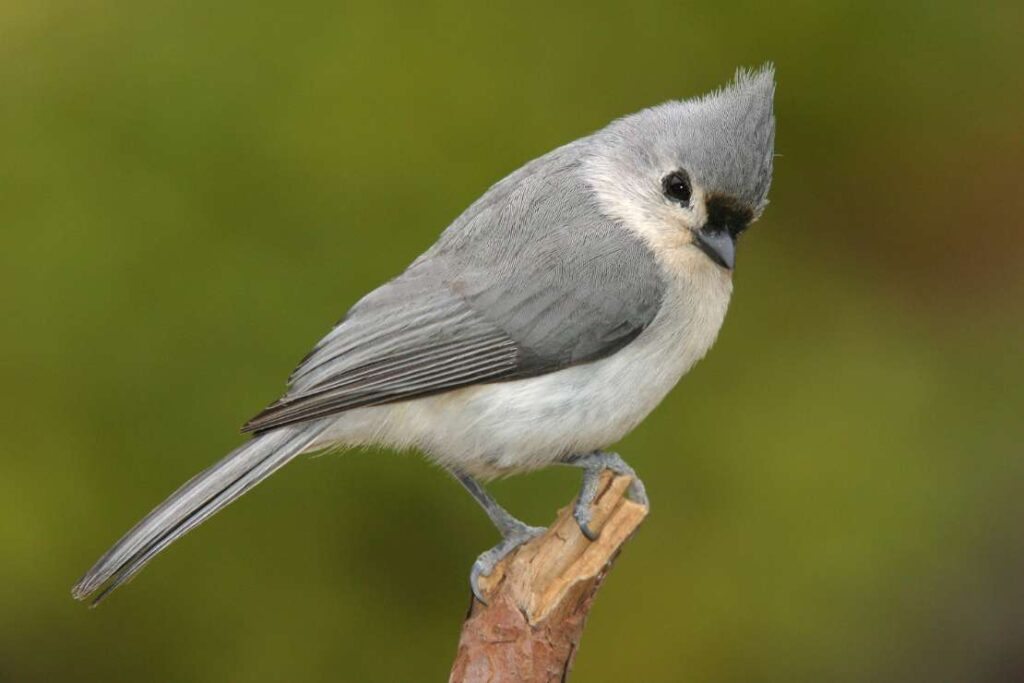
Adult specimens have bluish-grey upper parts, a prominent crest on top of the head, and a black forehead.
Their underparts are pristine white, with buff-toned sides and flanks. Despite their small size, these birds can live for anywhere from 2.1 years to more than a decade.
Size, weight, wingspan, lifespan and conservation status of Tufted Titmouse:
- Size: 14 to 16 centimeters (5.5 to 6.3 inches)
- Weight: 17 to 26 grams (0.6 to 0.9 oz)
- Wingspan: 20 to 26 centimeters ( 7.9 to 10.2 inches)
- Lifespan: 2.1 years
- Conservation status: Least concern
Tufted titmice are common in eastern woodlands, particularly below 2,000 feet elevation, where they thrive among the thick leaves of deciduous and evergreen forests.
However, their adaptability extends beyond natural habitats, as these attractive birds are commonly seen at household feeders, parks, and orchards.
Insects account for roughly two-thirds of their annual intake.
Caterpillars are the predominant meal during the warmer months, although tufted titmice also eat bees, wasps, sawfly larvae, beetles, scale insects, true bugs and different eggs and pupae.
Furthermore, these hardworking birds augment their diet with the occasional spider or snail.
2. Crested Auklet (Aethia Cristatella)
The Crested Auklet is a small seabird that lives in the North Pacific Ocean. The auklet body is generally black, with white patches or markings on its wings and belly.
Crested Auklets have compact bodies, short proportions, and long wings. Their thick plumage is consistently slate-gray or black, with bright yellow eyes.
Their feet, which are fitted with webbing for aquatic prowess, are strikingly black.
During the breeding season, these winged creatures undergo a dramatic transformation: their little, robust bills turn a brilliant shade of orange-red, accented by multicolored plates placed at the bill’s corners, adding a sparkling touch to their look.
It has a striking curling crest known as a mohawk, which is black.
This fashionable bird uses its crest not only for aesthetic purposes, but also to perform courtship rituals and exert supremacy over competitors.
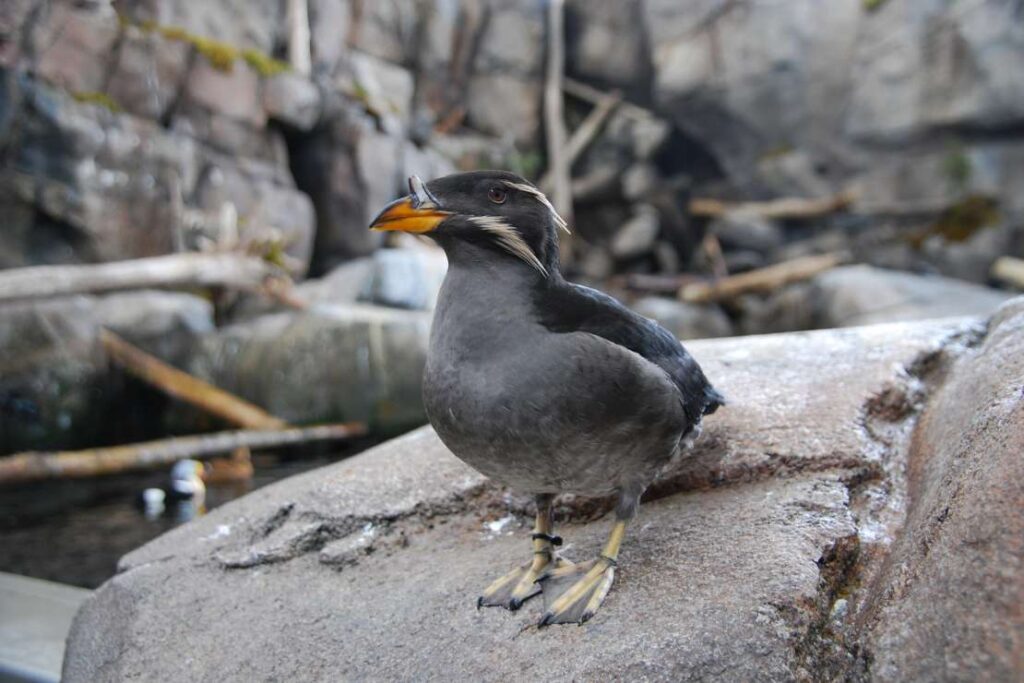
These auklets spend the majority of their life at sea and only return to land during the breeding season. Their lifespan is expected to be approximately seven years.
Size, weight, wingspan, lifespan and conservation status of Crested Auklet:
- Size: 18 to 27 centimeters (7.1 to 10.6 inches)
- Weight: 195 to 330 grams ( 6.9 to 11.6 oz)
- Wingspan: 34 to 50 centimeters ( 13 to 20 inches)
- Lifespan: seven years
- Conservation status: Least concern
These auklets spend most of the year immersed in the expanse of the ocean, only venturing onto land to reproduce.
They live along the beaches of islands. Their diet includes squid, planktonic crustaceans, comb jellies, and worms.
Surprisingly, copepods and other planktonic crustaceans account for 90% of their nutritional intake
3. Cockatiel (Nymphicus Hollandicus)
The Cockatiel, popular among pet owners, appeals with its charming mohawk-like crest on its head.
It can be identified by a prominent mohawk-like crest on top of their heads, which can vary in colour according to the bird’s genetics.
Females and kids Cockatiels have yellow barring on their tails, and females may also have modest yellow flecking on their heads.
Males, on the other hand, change as they mature, losing the tail barring and obtaining a bright yellow hue on their heads.
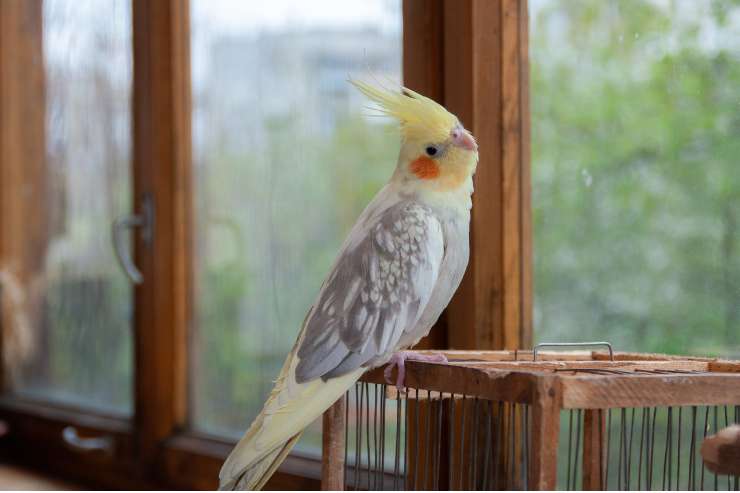
Moreover, Yellow and white are the most popular colours for cockatiels’ crests.
However, if a cockatiel has a mutation that changes pigmentation, the crest may be a different colour, such as grey, cinnamon, pied, or a combination of colours.
Since each Cockatiel’s colouration is unique, the colour of the mohawk will differ from bird to bird. It’s part of what makes these birds so attractive and fascinating.
Cockatiels in the wild often live for around 10 to 14 years.
Size, weight, wingspan, lifespan and conservation status of Cockatiel:
- Size: 30 to 33 centimeters (12 to 13 inches)
- Weight: 18 to 125 grams ( 2.75 to 4.40 oz)
- Wingspan: 25 to 30 centimeters (10 to 12 inches)
- Lifespan: 10 to 14 years in the wild
- Conservation status: Least concern
Cockatiels, which evolved in Australia, are extraordinarily versatile in their habitat choices.
These birds thrive in arid or semi-arid environments and have an incredible capacity to stay close to water sources.
Their migratory inclinations are quite astonishing, as they easily traverse geographies to reach locations rich in food and water.
Cockatiels eat a variety of seeds, including grass seeds, as well as fruits, berries, and vegetables.
Their feeding behaviours usually involve hunting on or near the ground, where they may quickly reach their favourite food sources.
4. Sulphur-crested Cockatoo (Cacatua Galerita)
Sulphur-crested Cockatoos are giant bird species known for their mostly white feathers and typical mohawk.
These birds have a distinctive look, with dark beaks and stunning yellow crests on their heads.
While their bodies are mostly white, yellow appears on their mohawks, as well as underneath their wings and tails.
Although males and females have comparable physical characteristics, minor differences emerge upon closer inspection.
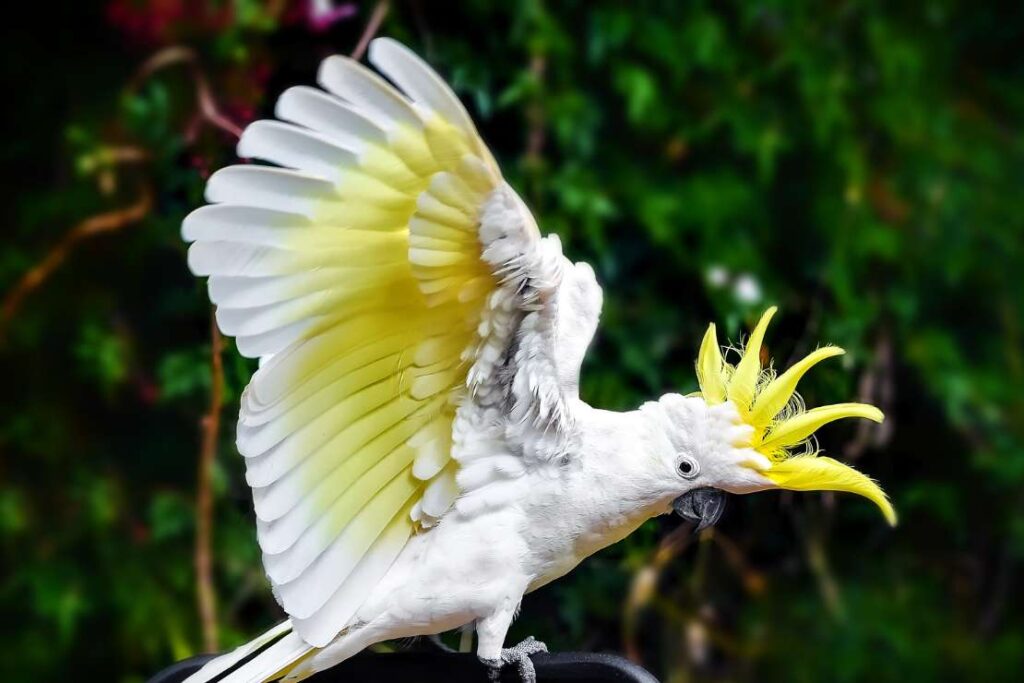
Notably, the female has a red-brown eye that is somewhat darker than the male’s, which serves as a critical identifying trait when studied closely.
Sulphur-crested Cockatoos can live between 20 and 40 years in the wild; however, with reasonable care, they can live up to 80 years in captivity.
Size, weight, wingspan, lifespan and conservation status of Sulphur-crested Cockatoos:
- Size: 41 to 51 centimeters ( 16.14 to 20.07 inches)
- Weight: 771.10 grams (27.19 oz)
- Wingspan: 103 centimeters ( 40.55 inches)
- Lifespan: 20 and 40 years in the wild and 80 years in captivity
- Conservation status: Least concern
Sulphur-crested Cockatoos live in a variety of tree-rich settings, with a preference for areas near water sources.
Unlike migratory species, these birds live quiet lives, generally residing in the exact location throughout the year.
They showed extraordinary adaptation to both urban and rural environments, thriving on farms and in cities alike.
Sulphur-crested Cockatoos are widely spread throughout the northern, eastern, and southeastern areas of Australia.
The diet of these birds includes grass seeds, plants, nuts, and insects.
Furthermore, while not actively looking for food, these cockatoos have a habit of biting tiny branches and leaves from trees.
5. Crested Guineafowl (Guttera Pucherani)
Crested guineafowl, members of the Guttera genus, are a trio of species in the Numididae family, which includes guineafowl birds.
The Crested Guineafowl, a terrestrial bird unique to particular regions of Africa, is known for its loud sounds and striking appearance.
They typically gather in groups. This species has a remarkable mohawk-like black crest on its head and dark grey to black plumage with pale streaks.
Their bare heads and necks, highlighted by brilliant red skin around their eyes and blue-hued necks, add to their distinct appearance.
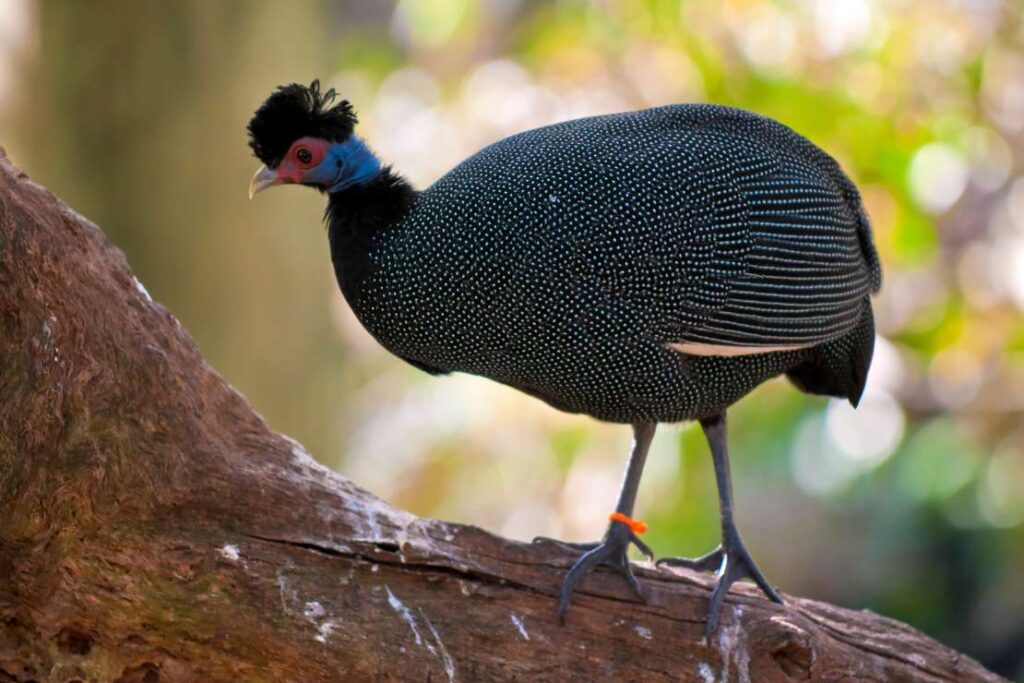
The crested guineafowl population remains stable, earning the species a least concern rating from the IUCN.
These Crested Guineafowl prefer communal living and form flocks of many individuals. They can live for up to two decades.
Size, weight, wingspan, lifespan and conservation status of Crested Guineafowl:
- Size: 50 centimeters (20 inches)
- Weight: 721 to 1543 grams (25.43 to 54.42 oz)
- Wingspan: 150 to 180 centimeters (59 to 71 inches)
- Lifespan: 12 years in captivity and 5 years in the wild
- Conservation status: Least concern
These bird species live in a variety of habitats throughout sub-Saharan Africa, including open forests, woods, and forest-savanna mosaics.
The crested guineafowl lives on a overall diet of insects, worms, seeds, berries, small animals, and reptiles.
6. Blue Jay (Cyanocitta Cristata)
The Blue Jay, a common and large songbird, is easily identified by its brilliant blue, white, and black plumage, perky crest, and unique vocalizations.
They can modify the position of their crest depending on their mood. Researchers researching these birds in their natural habitat have reported an individual Blue Jay surviving up to 17 years and six months.
However, the average lifespan of the Blue Jay is around seven years. Currently, the Blue Jay is classified as Least Concern, having a stable population.
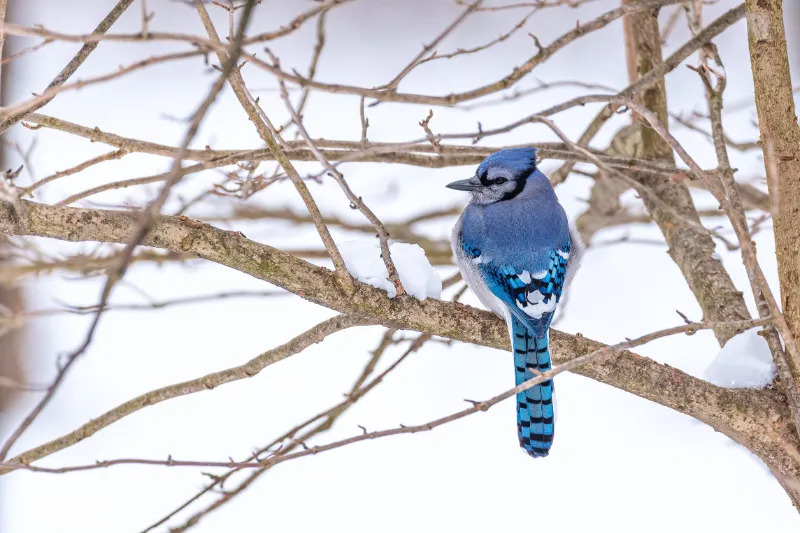
Size, weight, wingspan, lifespan and conservation status of Blue Jay:
- Size: 25 to 30 centimeters ( 10 to 12 inches)
- Weight: 70 to 100 grams (2.5 to 3.5oz)
- Wingspan: 34 to 43 centimeters (13 to 17 inches)
- Lifespan: 7 years
- Conservation status: Least concern
The Blue Jay is a versatile bird that lives in a variety of environments, including Florida’s piney landscapes and northern Ontario’s spruce-fir woods.
While it is less common in deep forests, it prefers mixed woodlands and regions with deciduous trees, notably beech, hazel, and oak.
This omnivorous bird eats a diverse diet with a focus on plant-based items. It feeds on acorns, beechnuts, and other nuts, as well as seeds, grains, berries, and tiny fruits.
7. Victoria Crowned Pigeon (Goura Victoria)
The Victoria Crowned pigeon has a stunning deep blue-grey colouration with a little black mask.
Its most distinguishing feature, the feather crest, is adorned with white points. A row of feathers on its wing coverts is paler blue-grey, with maroon tips.
It has a flattened crown of feathers on its head, similar to a Mohawk appearance.
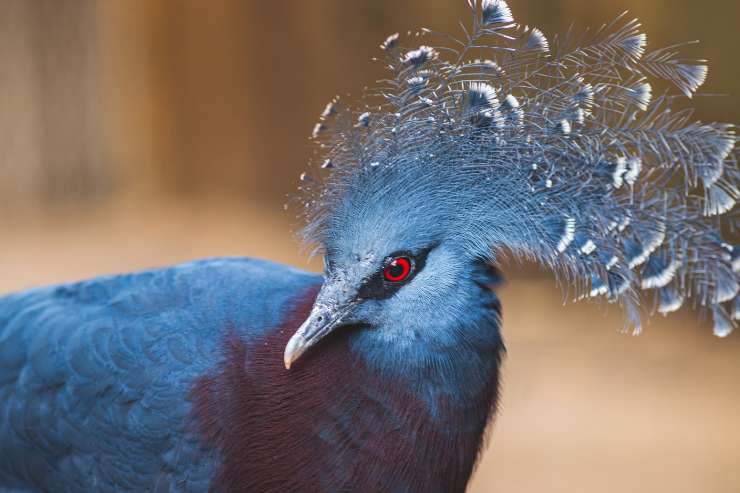
The Victoria crowned pigeon, with its unique physical features, is not just a pretty face. It has fascinating behaviour in captivity and often lives for 35 years or more.
| Note: Female Victoria Crowned pigeons typically start reproducing at the age of five, although they can lay their first egg as young as 1.5 to 2 years old. |
However, this bird’s future is uncertain. It is currently classified as near threatened, indicating a decline in its population and the need for immediate conservation efforts.
Size, weight, wingspan, lifespan and conservation status of Victoria Crowned Pigeon:
- Size: 73 to 75 centimeters ( 29 to 30 inches)
- Weight: 3492.66 grams ( 123.19oz)
- Wingspan: 36 to 39 centimeters ( 14 to 15 inches)
- Lifespan: 35 years or longer in captivity
- Conservation status: Nearly threatened
The Victoria crowned pigeon is often found in lowland and swamp forests throughout northern New Guinea and its neighbouring islands.
It typically lives in areas historically known as alluvial plains, notably sago forests.
In its natural habitat, this species is assumed to feed mainly on fallen fruits, seeds, berries, insects, and invertebrates.
In captivity, these birds eat papaya, bird maintenance pellets, mealworms, corn grubs, and speciality Bird of Paradise pellets provided by zoos.
8. Eurasian Hoopoe (Upupa Epops)
The Eurasian hoopoe, which belongs to the Upupa genus, is the most extensively spread species in its group.
It has an exotic appearance similar to that of a Mistle Thrush in size. The Eurasian hoopoe has a pinkish-brown body and beautiful black and white wings, as well as a distinctive downcurved black bill.
What actually distinguishes it is its striking black-and-white tipped orange mohawk, which it proudly raises when it gets excited. The Eurasian hoopoe has an average lifespan of about ten years in the wild.
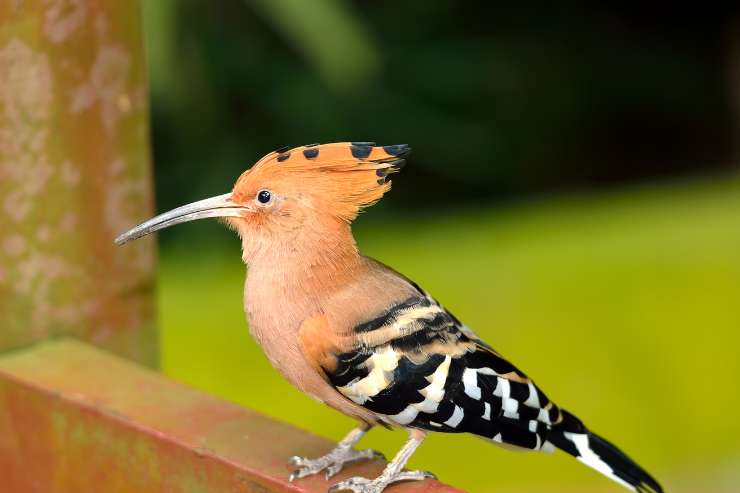
Size, weight, wingspan, lifespan and conservation status of Eurasian hoopoe:
- Size: 25 to 32 centimeters (9.8 to 12.6 inches)
- Weight: 46 to 89 grams (1.6 to 3.1 oz)
- Wingspan: 44 to 48 centimeters (17 to 19 inches)
- Lifespan: 11 to 12 years in captivity
- Conservation status: Least concern
The Eurasian hoopoe prefers semi-open areas such as heathlands, farmland, orchards, and grassy lawns.
These species’ food consists primarily of insects, but they also consume tiny reptiles, frogs, and plant material such as seeds and berries.
9. Great Curassow (Crax Rubra)
The Great Curassow is a large bird that resembles a pheasant and lives in the lush jungles of the Neotropics.
Male curassows have primarily black plumage with white feathers below and glossy patterns that, in certain circumstances, appear blue. Notably, males have a bright yellow knob at the base of their bills.
Females, on the other hand, come in a variety of colours, most commonly appearing reddish-brown or black with typical striped patterns on their heads and tails.
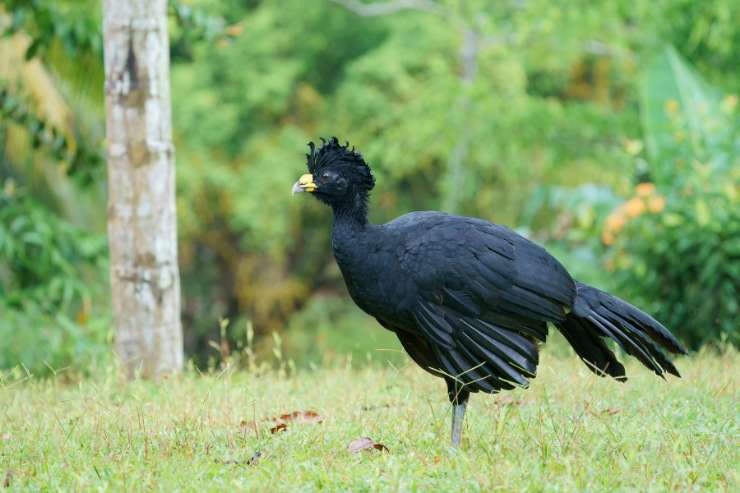
Both genders share a black mohawk, a defining feature. The Great Curassow has two subspecies and can live for up to 24 years. This species is considered vulnerable in terms of conservation status.
One subspecies is extremely rare, limited to the island of Cozumel, and contains only around 300, whilst the other is more widespread, ranging from eastern Mexico southward across Central America to western Colombia and Ecuador.
Size, weight, wingspan, lifespan and conservation status of Great Curassow:
- Size: 78 to 100 centimeters (31 to 39 inches)
- Weight: 3100 to 4800 grams (109.34 to 169.31 oz)
- Wingspan: 75 to 90 centimeters (29.52 to 35.43 inches)
- Lifespan: 24 years
- Conservation status: Vulnerable
The Great Curassow lives in rich lowland forests and coastal mangrove areas.
Its diet consists primarily of ripe fruit that has fallen from trees, although it also eats seeds, insects, and, sometimes, small lizards.
In zoos, the Great Curassow is fed a mix of seeds and fresh fruits to simulate its natural eating habits.
10. Smew (Mergellus Albellus)
The Smew duck is the only surviving member of the Mergellus genus. This small diving duck has a thin bill.
During the breeding season, males have a conspicuous white mohawk stripe running from the back of their heads to the nape, which stands out against their generally black plumage.
Females, on the other hand, have a calmer appearance, with greyish bodies and reddish-brown heads and no conspicuous mohawks.
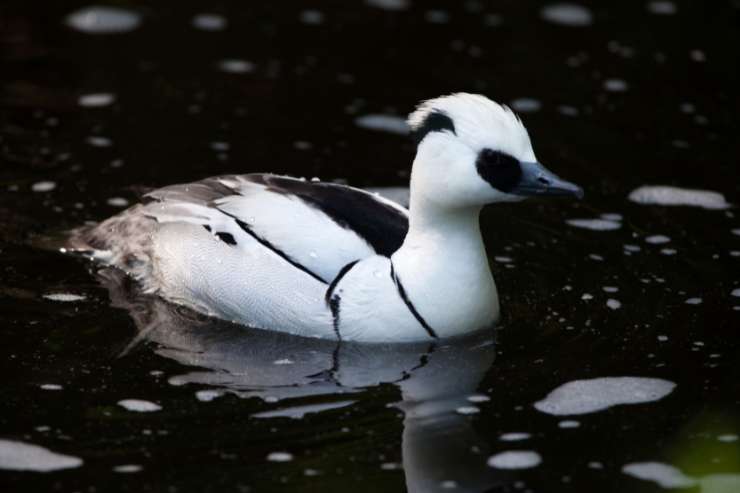
Notably, the Smew is designated as a species of least concern for conservation.
Size, weight, wingspan and conservation status of Smew:
- Size: 38 to 44 centimeters (15 to 17 inches)
- Weight: 450 to 650 grams (15.87 to 22.92 oz)
- Wingspan: 56 to 69 centimeters (22.04 to 27.16 inches)
- Conservation status: Least concern, but the population is decreasing
The Smew migrates seasonally, leaving its breeding areas to winter in sheltered beaches or inland lakes in the Baltic Sea, Black Sea, northern Germany, and the Low Countries. It lives in lakes and slow rivers that are rich in fish.
Occasionally, a few smews expand their range to Great Britain, such as at Dungeness, and frequently return to familiar places.
During the summer, it eats primarily aquatic insects, whereas in the winter, it eats mostly small fish.
11. Pileated Woodpecker (Dryocopus Pileatus)
The Pileated Woodpecker is a large woodpecker species native to North America. It has mostly black plumage, white face and neck stripes, and a vivid red crest.
Males are identified by their red cheek stripes. During flight, it has large white underwings and little white crescents at the bases of the upper primaries.
These birds are famed for their relatively long lives, which can last up to 12 years. The pileated woodpecker is not currently categorized as vulnerable or endangered, although it is protected.
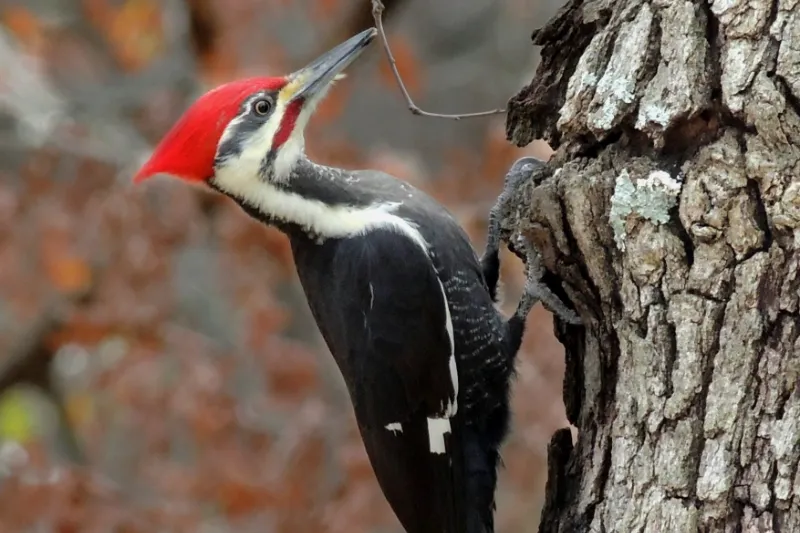
Size, weight, wingspan, lifespan and conservation status of Pileated Woodpecker:
- Size: 40 to 49 centimeters (16 to 19 inches)
- Weight: 225 to 400 grams (7.9 to 14.1 oz)
- Wingspan: 66 to 75 centimeters (26 to 30 inches)
- Lifespan: 12 years
- Conservation status: Least concern
The Pileated Woodpecker is found throughout the eastern United States, Canada, and parts of the Pacific Coast. It prefers mature woods and heavily wooded parks.
Their preferred habitats are mesic regions with large, mature hardwood trees, particularly in densely forested areas.
These woodpeckers typically feed on carpenter ants, but they also eat other ant species, woodboring beetle larvae, termites, and various insects, such as flies, cockroaches, grasshoppers, and caterpillars.
12. Royal Flycatchers (Onychorhynchus)
The Royal Flycatchers belong to the genus Onychorhynchus and are classified in the Tityridae family by the International Ornithological Committee (IOC).
They are well-known for their stunning, elongated crests in brilliant red and blue. This prominent crest, which is usually carried downward, contributes to the bird’s hammerhead-like look.
The Royal Flycatcher’s crest is a large brown bird with a buffy tail and little buff dots on the wings.
During times of excitement or courtship behaviours, the bird may raise its crest, increasing its visibility.
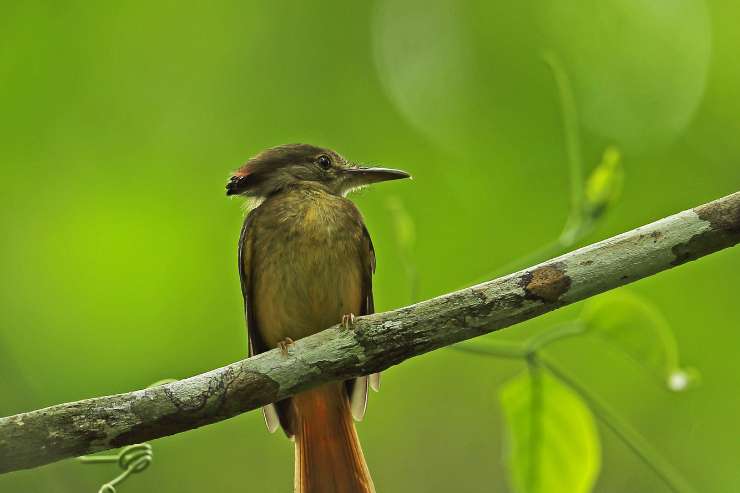
The Royal Flycatcher is categorized as vulnerable in terms of its conservation status and typically has a lifespan of six years.
Size, weight, lifespan and conservation status of Royal Flycatcher:
- Size: 12.5 to 18 centimeters (4.9 to 7.5 inches)
- Weight: 9.7 to 21 grams (0.34 to 0.74 oz)
- Lifespan: 6 years
- Conservation status: Vulnerable
The Royal Flycatcher is most commonly seen in the lower portions of wet evergreen or deciduous woods, although its range also includes mature secondary growth areas and forest borders.
The species, which may be found throughout this wide range, relies primarily on insects and follows an insectivorous diet.
13. Hooded Merganse (Lophodytes Cucullatus)
The Hooded Merganser, a fish-eating duck species from the subfamily Anatinae, is the only alive member of the genus Lophodytes.
Adult male Hooded Mergansers have black upperparts, a white breast, and striking chestnut flanks.
Their black heads have a distinctive white patch, which varies in size with the movement of the crest but is always visible.
Similarly, females and babies have grey and brown plumage with warm, tawny-cinnamon tones on the head.
In the wild, these ducks typically live for 11 to 12 years, but in captivity, their longevity averages 13 years and 4 months.
The Hooded Merganser’s oldest documented age is 14 years and six months.
Despite being classed as a species of least concern and not on the endangered list, the Hooded Merganser’s future may not be hopeful.
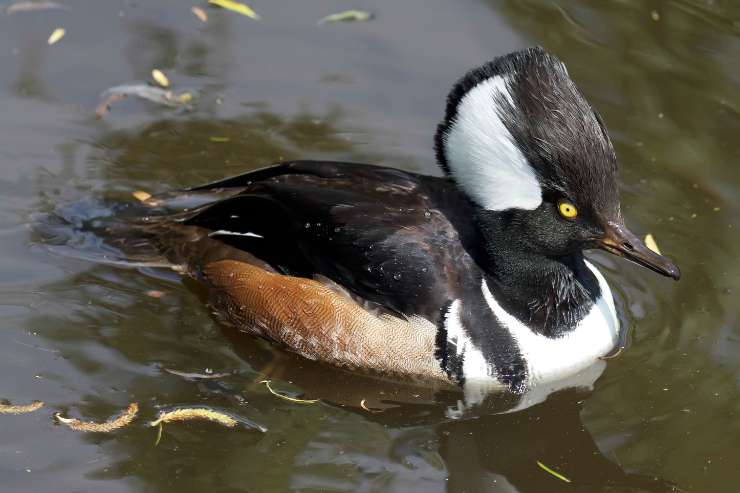
Deforestation and pollution in stream water have drastically reduced their breeding habitats.
Size, weight, wingspan, lifespan and conservation status of hooded merganse:
- Size: 41 to 48 centimeters (16.41 to 18.89 inches)
- Weight: 544.31 to 680.38 grams (19.19 to 23.99 oz)
- Wingspan: 56 to 70 centimeters (22.4 to 28 inches)
- Lifespan: 11 to 12 years in the wild and 13 years and 4 months in captivity
- Conservation status: Least concern
Hooded Mergansers primarily breed in southeastern Canada. During the winter, they migrate to numerous locations, including the East Coast of the United States, the Gulf Coast, and, to a lesser extent, California, Oregon, and Washington.
Hooded Mergansers’ habitats primarily consist of wooded sloughs, streams, and marshes. They feed mainly on fish, crabs, and aquatic insects.
14. Golden Pheasant (Chrysolophus Pictus)
The Golden Pheasant, commonly known as the Chinese or Rainbow Pheasant, belongs to the Galliformes order and the Phasianidae family.
Male golden pheasants have a distinctive golden-yellow crest with a tinge of scarlet at the tip. Their face, throat, chin, and neck are reddish tan, with yellow wattles and orbital skin.
A light orange ruff or cape covers their top back, while the rest of the back and rump are golden-yellow. Golden pheasants are very colourful birds.
These pheasants typically survive for 5 to 6 years in their natural habitat but can flourish for up to 20 years in captivity.
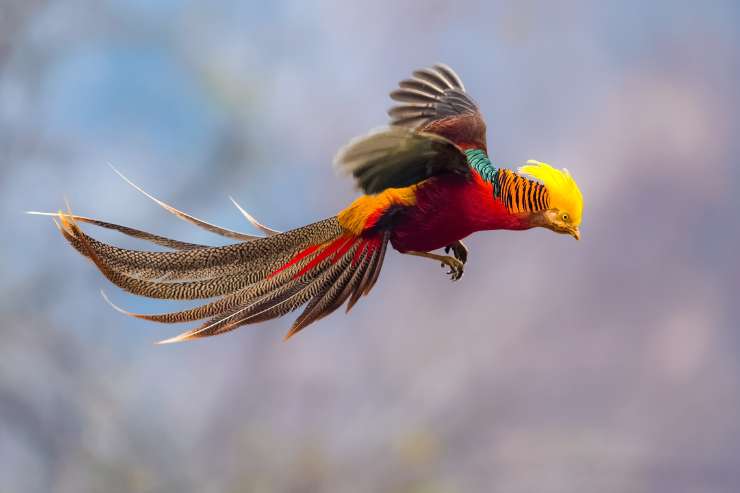
Golden pheasants are not currently threatened and are classified as a species of least concern.
However, in specific locations, their populations may be on the decline due to factors like deforestation, hunting for eating, and capture for the pet trade.
Size, weight, wingspan, lifespan and conservation status of golden pheasant:
- Size: 90 to 115 centimeters (35.4 to 45.3 inches)
- Weight: 544.31 to 680.38 (19.19 to 23.99 oz)
- Wingspan: 65 to 75 centimeters (25.6 to 29.5 inches)
- Lifespan: 5 to 6 years in the wild and 20 years in captivity
- Conservation status: Least concern
The golden pheasant lives in hilly forested regions of western China, as well as sections of western Europe, North and South America, New Zealand and Australia.
These herbivorous pheasants eat a variety of foods to sustain themselves.
They eat berries, grubs, seeds, leaves, tender shoots of shrubs and bamboo, flowers and other flora, and insects and spiders on occasion.
15. Turaco (Musophagidae)
Turacos are medium-sized birds in southern Africa that are also known as “loeries” or go-away birds.
White-crested turacos are distinguished by their brilliant appearance, which includes light green body plumage, dark blue to purple back, wings, and tail, a jet black face, red eye ring, and bright yellow beak.
Their long black tail, white chin, neck, and nape all add to their remarkable appearance.
Notably, the beautiful red colouration under their wings is caused by pigments within the feathers, not by exterior light reflection.
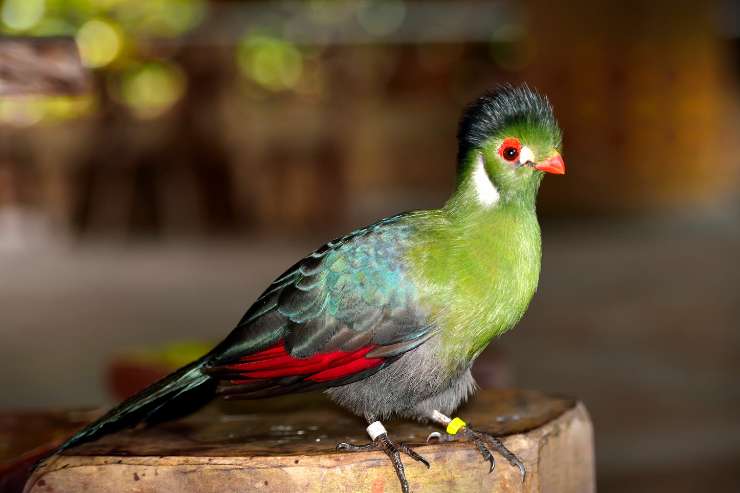
These birds can survive for 20 to 30 years in captivity but only 10 to 15 years in the wild. According to IUCN, Turacos are considered a nearly threatened species.
Size, weight, wingspan, lifespan and conservation status of turaco:
- Size: 40 to 75 centimeters (16 to 30 inches)
- Weight: 816.46 to 1224.7 grams (28.79 to 43.20 oz )
- Wingspan: 20.32 centimeters (8 inches)
- Lifespan: 20 to 30 years in captivity and 10 to 15 years in the wild
- Conservation status: Least concern
These birds thrive in a variety of natural environments, including subtropical or tropical wet lowland forests, subtropical or tropical moist montane forests, and agricultural regions.
Turacos eat both wild and cultivated fruits, with occasional eating of leaves, flowers, and buds.
They may also eat caterpillars, slugs, beetles, moths, termites and snails, particularly during the breeding season.
16. Great Bowerbird (Chlamydera Nuchalis)
The Great Bowerbird’s colour is mostly grey and brown, with unique white scalloping on its back.
Female birds, while smaller in size, may lack the distinctive pink crest observed in males.
Males of this species are known for their fantastic building abilities, creating huge bowers made of twigs and grasses.
These birds’ structures are adorned with various small objects, which are frequently painted red, green, or white.
They are famous for their distinctive appearance and are commonly referred to as the birds with pink mohawks.
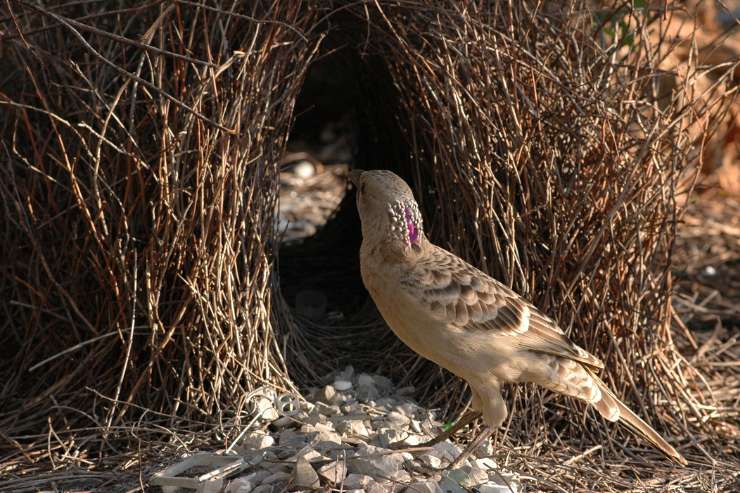
Despite their fantastic longevity among the passerine family, with an average lifespan of ten years, there have been unusual examples, such as a Satin bowerbird observed by the Australian government, which has lived for nearly 26 years.
The Great Bowerbird is a species of least concern, but its population is declining.
Size, weight, lifespan and conservation status of Great Bowerbird:
- Size: 33 to 38 centimeters ( 12.99 to 14.96 inches)
- Weight: 230 grams (8.1 oz)
- Lifespan: Ten years
- Conservation status: Least concern
The Great Bowerbird prefers a variety of environments, including broad forests, woodlands, the borders of vine forests, monsoon forests, and mangrove swamps.
The Great Bowerbird has a varied diet that includes fruits, flowers, nectar, green plants, tiny animals (mostly insects), seeds, and sometimes food remnants.
Figs from the Ficus genus are important nutritional essentials for these species.
17. Steller’s Jay (Cyanocitta Stelleri)
The Steller’s Jay is a robust and crested bird known for its remarkable look. Its plumage is a blend of charcoal black and vivid blue, making it incredibly appealing.
Adult Steller’s Jay around the Pacific Coast have additional blue streaks on their black crests, which adds to their appeal.
This avian species has a distinctive mohawk-like crest that usually matches the deep blue colour of its body feathers.
While pigmentation may differ between birds, the overall impression stays consistent. This crest often grows more prominent when the bird is excited or alarmed, emphasizing its distinctive features.
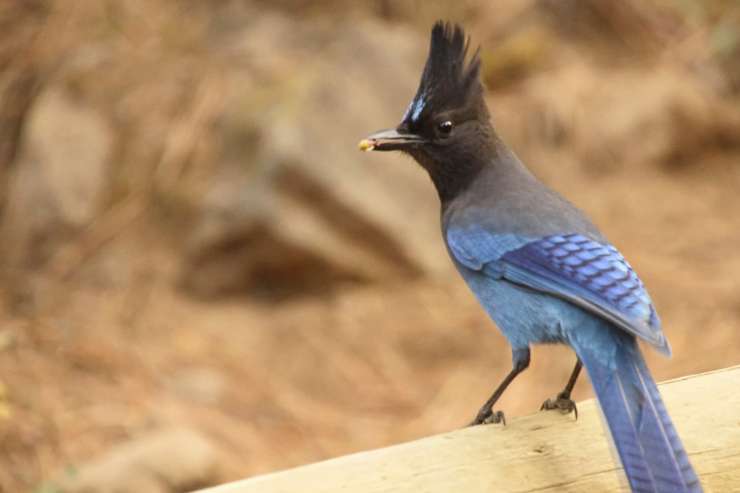
Notably, the lifespan of this species is highlighted by the oldest reported Steller’s Jay, a male found in Alaska in 1987, which was documented to be at least 16 years and one month old
Size, weight, lifespan and conservation status of Steller’s jay:
- Size: 30 to 34 centimeters ( 12 to 13 inches)
- Weight: 100 to 140 grams (3.5 to 4.9 oz)
- Lifespan: 16 years and 1 months
- Conservation status: Least concern
Steller’s Jays can be found in coniferous and mixed mountain forests in western North America, from southern Alaska to the foothills of the Rocky Mountains.
| Note: Although Blue Jays and Steller’s Jays belong to the same family, Corvidae, they are distinct birds. |
Although there is occasional hybridization with Blue Jays in select locations, Steller’s Jays maintain their characteristics.
Nevertheless, being frequently confused with their blue counterparts, with Blue Jay birds, they carve out their own place in their surroundings.
How to Identify Birds with Mohawks?
Identifying birds with mohawks can be a fun task for birdwatchers and photographers. Here are some ideas to help you determine this stylish bird:
- Look for a crest: Birds with mohawks usually have a prominent crest on their heads. The size, form, and colour of the crest might vary; therefore, pay attention to these characteristics while identifying a bird.
- Observe the bird’s behaviour: Some birds with mohawks only show their crests in certain conditions, such as courtship displays or territorial fights. Observing the bird’s behaviour may provide insight into the purpose of its crest.
- Consult field guides and internet resources: Field guides and internet bird identification tools might help you learn more about birds with mohawks. Look for unique characteristics or patterns that can assist you in identifying a particular species.
- Join birdwatching groups or clubs: Meeting other experienced birdwatchers can help you identify birds with mohawks. These groups frequently organize birding expeditions and might offer advice and assistance in your birdwatching pursuits.
Conclusion
To summarize, birds with mohawks are an exciting and diverse collection of avian creatures. These unique creatures show nature’s boundless creativity of life on our planet.
Their distinct styles and behaviours never fail to captivate us, leaving us in awe of the wonders of the natural world.
As we continue to study to understand these beautiful birds better, let us commit to safeguarding their habitats and ensuring their survival.
Next time you see a bird with a mohawk, admire its beauty and the evolutionary journey that led to its existence.
Let this be a reminder to safeguard the environment and its inhabitants for future generations to appreciate and wonder at.
Whether you’re a birdwatcher, a nature lover, or simply someone who appreciates the beauties of the natural world, exploring the world of birds with mohawks will be a wonderful experience.
So, grab your binoculars, head out into the woods, and appreciate the unique beauty of birds with mohawks.
Frequently Asked Question
How to attract birds with a mohawk to the backyard?
Create a bird-friendly environment in your backyard; it will provide a wonderful opportunity to see these magnificent creatures up close. Enhancing your habitat with native plants, water sources, and predator-prevention measures is a critical stage in attracting birds with distinctive mohawks. Additionally, offering appropriate food that meets their dietary needs can tempt these birds to visit your yard. By researching the individual bird species in your area and understanding their preferences, you can make your backyard a welcoming shelter for them.
Why are conservation efforts crucial for birds with mohawks?
Like many other species, birds with mohawks face a variety of issues, including climate change, habitat loss, and human-caused activities. These dangers endanger the survival of these unique species of birds, emphasizing the crucial need for conservation efforts. By implementing appropriate conservation measures, we can safeguard these rare birds and ensure their survival for future generations to enjoy.






